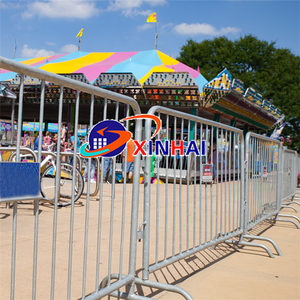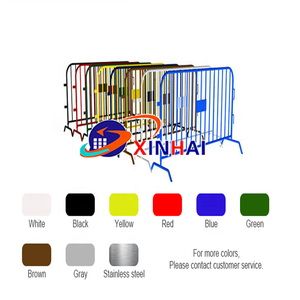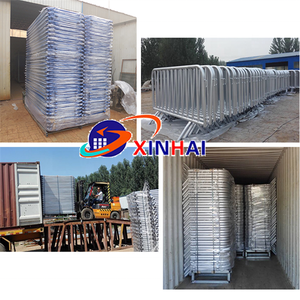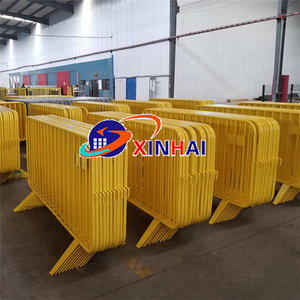(10486 products available)































































































































































































Safety fences are barriers designed to prevent accidents and injuries by providing protection in areas where there may be potential hazards. Here are some common types of safety fences:
Pool safety fence
Pool safety fences are barriers installed around swimming pools to prevent young children and pets from entering the pool area without supervision. These fences typically have a gate that opens and closes with a self-closing and self-latching mechanism for easy access while ensuring that the gate remains closed when not in use. The vertical picket design prevents children from slipping through, and the height of the fence makes it difficult for them to climb over. Some pool safety fences are removable, allowing for flexibility in usage, while others provide a more permanent solution. They come in various materials, such as aluminum, mesh, and wrought iron, and are an important safety feature for homes and commercial properties with pools, giving peace of mind to owners and guardians.
Construction site fence
Construction site safety fences are temporary barriers installed around construction sites to secure the area and protect workers, visitors, and the general public from hazards. These fences, often made of durable materials like chain link or mesh, help prevent unauthorized access to the site, which could lead to accidents. They may also include warning signs about potential dangers, such as falling objects or deep excavations. Some construction site fences are designed to contain dust and debris within the work area, while others are equipped with safety features like wind resistance and collapse prevention for scaffolding. Overall, construction site safety fences play a critical role in maintaining safety and security at construction sites.
Child safety gate
Child safety gates are barriers used to prevent young children from accessing areas where they could be at risk, such as stairs, kitchens, or playrooms. These gates are typically installed across openings and come in various sizes and styles to suit different spaces. Made from sturdy materials like wood, metal, or plastic, child safety gates are designed to be difficult for small children to open or climb over while allowing adults to pass through easily. They often feature a simple latch mechanism that can be operated with one hand and may include pressure-mounted designs that require no drilling or permanent installation. Child safety gates provide peace of mind for parents and caregivers by helping keep young children safe within designated areas.
Temporary safety fence
Temporary safety fences are short-term barriers used in various situations where a quick and effective safety solution is needed. These fences are often made from lightweight materials like plastic mesh or metal to ensure easy installation, portability, and cost-effectiveness. They are commonly used at construction sites, road work zones, event venues, or areas with hazardous conditions to secure the site, prevent unauthorized access, and protect people from potential dangers. Temporary safety fences can be designed to contain debris, control dust, and shield work areas, and are typically available in sections that can be easily assembled and disassembled as required. Despite being temporary, these fences must meet the necessary safety standards and be visibly marked to alert the public to their presence.
Pool safety fences:
These are designed to be aesthetically pleasing while providing safety. They come in a variety of colors and materials, such as aluminum or mesh, and can be either removable or permanent.
Child safety gates:
These gates often feature a latch system that is difficult for children to reach but easy for adults. Some designs swing open both ways, while others swing one way only to prevent accidents.
Fireplace safety screens:
These screens come in many styles, from modern metal to classic brass, and can be found in folding, stationary, or screen formats.
Safety railings:
Railings are designed to blend with existing decor and come in various finishes, including wood, metal, and glass. They can be mounted to the wall or freestanding and often feature decorative elements.
Corner protectors:
Corner guard safety fences are made to blend in with furniture or walls and are often made from clear plastic or vinyl, allowing the furniture's original color and design to show through.
High chairs and strollers with safety fences:
These items feature safety harnesses and seat belts, designed to be easy to use but secure. They may also include removable trays that lock into place.
Safety pool fences:
These fences are usually made from mesh or aluminum and come in various colors. They can be removable or permanent and often include self-closing, self-latching gates.
Child safety gates:
Safety gates come in various widths to fit different openings and can be pressure-mounted or wall-mounted. They often have adjustable height settings and come in various colors and finishes to match home decor.
Fireplace safety screens:
Fireplace screens are made from metal, glass, or a combination of both and come in various sizes and styles, including mesh panel screens, folding screens, and decorative screens with artwork or patterns.
Safety fences are important in many industries and use cases. They are used where there is a risk of falling from heights. Examples include construction sites, rooftops, decks, and mining areas. Safety fences prevent people from falling off the edge and getting hurt. Safety fences are also used in factories and warehouses to keep workers away from dangerous machines and to prevent accidents. In industrial sites, safety fences often keep large vehicles like forklifts away from pedestrian walkways to minimize the risk of collisions.
Another common use of safety fences is in temporary work zones. These areas are created on roads and highways for construction, repair, or maintenance work. Safety fences direct traffic away from work zones and protect workers from oncoming vehicles. Safety fences are also used in event management. They help control crowds and keep people safe from restricted or hazardous areas. Similarly, safety fences are used in amusement parks and zoos to keep guests safe and prevent animal encounters.
Safety fences are also used in residential settings. They are installed around swimming pools to prevent young children from drowning. Child safety fences are used in yards to keep kids away from any potentially dangerous things like gardening tools or wildlife. Safety fences are also used on stairs inside homes to prevent young children from falling. In each of these situations, the safety fence serves as a critical barrier that helps prevent falls, keeps people away from hazards, and generally reduces the risk of accidents and injuries.
Choosing the right safety fence for a project involves considering several important factors. First, it is crucial to clearly identify the specific safety requirements and purposes of the fence. Will it be used to protect children, pets, or to create secure construction sites? Understanding the primary function of the fence will help narrow down the options available.
Next, one should consider the material. Safety fences are commonly made from materials such as steel, aluminum, mesh, or wood. Each material has its own advantages and drawbacks in terms of durability, maintenance, installation ease, and cost. For instance, steel fences are very durable and long-lasting, while mesh fences offer visibility and airflow.
Additionally, one must evaluate the fence's height and strength. Depending on the application, a higher or more robust fence may be necessary. For example, when using a safety fence for pool areas, child safety fences that are at least four feet high are recommended to prevent young children from wandering near the water.
Moreover, it is important to check local building codes and regulations regarding safety fences. These codes often specify minimum standards for height, gate locks, and other safety features. Complying with these regulations is not only legally required but also ensures that the fence will be safe and effective.
Furthermore, one should look for additional safety features such as self-closing and self-latching gates, smooth and rounded edges to prevent injuries, and visibility at night. These features enhance the overall safety of the fence and reduce the risk of accidents.
Lastly, considering the ease of installation and maintenance is crucial. One should choose a safety fence that can be easily installed and maintained over time, saving both time and costs in the long run. In conclusion, choosing the right safety fence involves identifying specific safety requirements, considering the material and its attributes, evaluating height and strength, complying with local regulations, looking for added safety features, and considering ease of installation and maintenance. By carefully considering these factors, one can choose a safety fence that will effectively protect people and property.
Q1: Can baby gates be attached to walls without drill holes?
A1: Some baby gates can be attached to walls without drilling holes, such as pressure-mounted gates. These gates use opposing forces to create a secure fit against the walls, which is ideal for temporary setups or those who don't want to make permanent fixtures.
Q2: How can safety gates be cleaned and maintained?
A2: To clean safety gates, users should use a mild soap solution and a soft cloth, making sure not to employ any abrasive cleaners or tools that could damage the surface. Regularly checking the gate for any signs of wear or tear and ensuring that all screws and fittings are tight will keep the gate in proper working condition.
Q3: Are safety gates compatible with all types of stairs?
A3: Safety gates are appropriate for all sorts of stairs. However, some gates may be better suited to specific stair designs. Users should choose a gate that fits the top and bottom of their stairs and meets its requirements.
Q4: Can safety fences be used outdoors?
A4: Many safety barriers are designed for internal use only; however, some fences can be utilized externally. Users should look for gates that can withstand outdoor conditions, such as being made of rust-resistant materials.
Q5: What is the lifespan of a safety fence?
A5: The lifespan of a safety fence can vary depending on its material, usage, and maintenance. Wooden fences may last 5 to 10 years with proper care, while vinyl, metal, and composite fences can last 20 years or more.